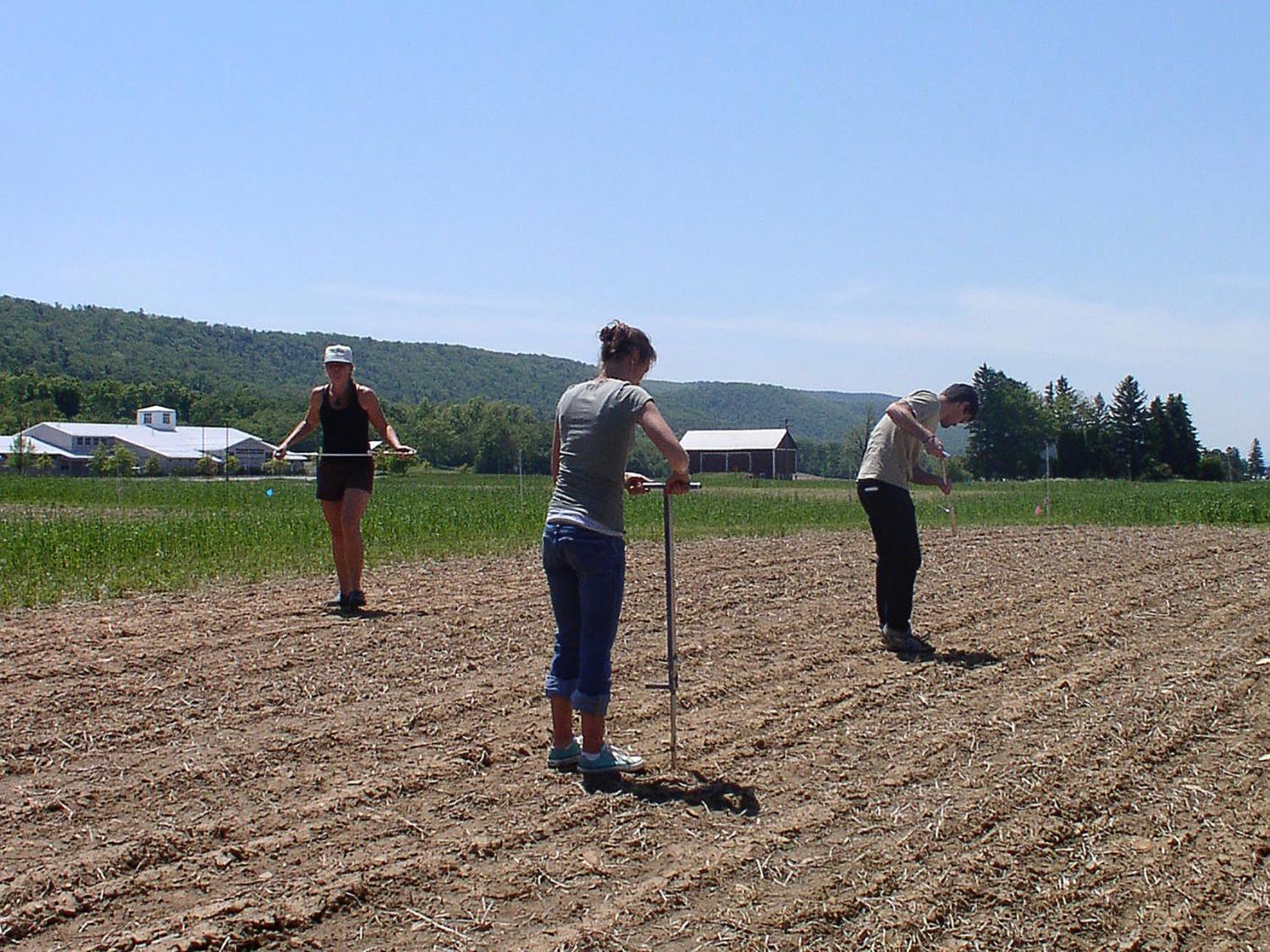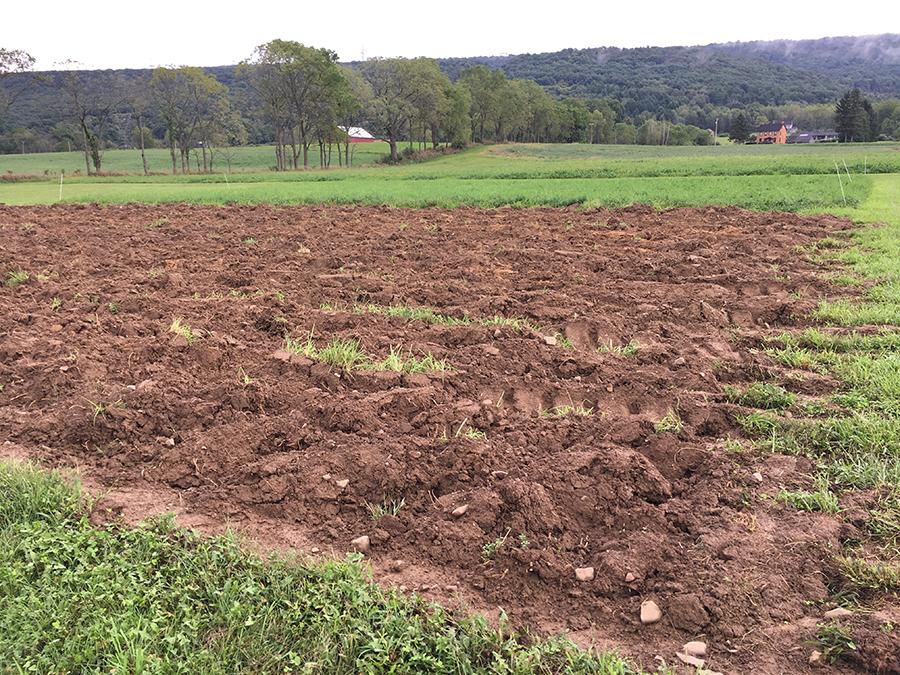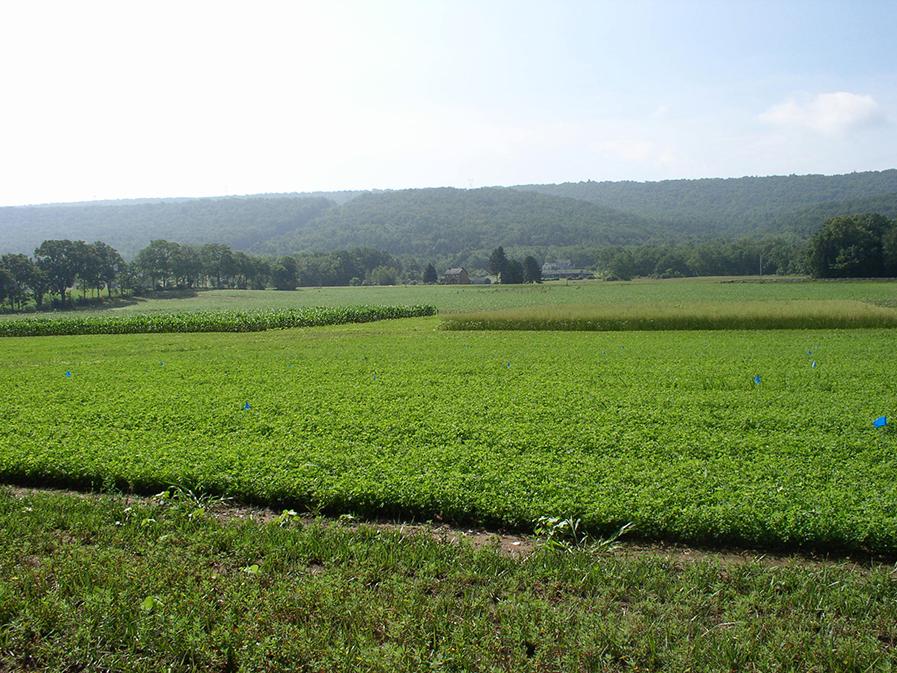From The College of Agricultural Sciences
At
The Pennsylvania State University
12.22.22
Jeff Mulhollem
jjm29@psu.edu
814-863-2719

Researchers test soil health indicators in a plot at Penn State’s Russell E. Larson Agricultural Research Center. Credit: Penn State. Creative Commons.
Many no-till growers are reluctant to implement any soil disturbance due to concerns about negative impacts on soil health. However, a new study by a team of Penn State researchers suggests that plowing fields once after five years in a crop rotation that includes coverage with cover crops and perennials can maintain soil health and provide other benefits.
“Although no-till has proven to be very good for soil health, and its wide adoption in Pennsylvania and the Northeast has resulted in reductions in erosion and sedimentation, it has resulted in the emergence of herbicide-resistant weeds because no-till farmers rely on herbicides to control weeds and terminate cover crops,” said team leader Heather Karsten, associate professor of crop production/ecology. “And that has created a big weed-control problem.”
Karsten, whose research group in the College of Agricultural Sciences for nearly two decades has studied how dairy farms can produce crops more sustainably, pointed out that reliance on herbicides such as glyphosate may have negative environmental impacts and human health concerns. Instead, Penn State scientists advocate integrated weed management, which employs multiple weed-control practices.

The findings of the research suggest that growers can avoid the expense of applying so many herbicides and avoid contaminating their ecosystems by implementing very limited strategic tillage. And in the long run, the health of their soils will remain largely unchanged and protected. Credit: Penn State. Creative Commons.
There are many benefits to no-till agriculture, Karsten noted, but one of its downsides is that growers repeatedly use herbicides to kill the cover crops and perennials in their rotations. It’s an environmental load that can and should be reduced, she argues, because no-till has been so widely adopted. For instance, a 2017 survey by the U.S. Department of Agriculture revealed that 67% of crop acreage in Pennsylvania was managed with no-till and 24% with cover crops.
“When you use herbicides again and again to burn down the cover crops and kill the perennials, that selects for herbicide-resistant weeds and contaminates the environment,” she said. “There is growing evidence that herbicides such as glyphosate and 2,4-D that are commonly used to burn down cover crops and control weeds pose some human-health problems, such as non-Hodgkin lymphoma and endocrine disruption. These and other herbicides used to control herbicide-resistant weeds also are toxic to soil organisms and wildlife.”
In the six-year experiment conducted at Penn State’s Russell E. Larson Agricultural Research Center, researchers contrasted two cropping systems: a continuous no-till system using herbicides, and an integrated weed management system using strategic inversion tillage and fewer herbicides. They measured soil health indicators, such as levels of desirable soil carbon and water-stable aggregates, which refers to a desirable soil-clumping quality that promotes soil porosity, facilitates water and air infiltration, reduces soil erosion and enhances growing conditions for plant roots and soil organisms.

A 2017 survey by the U.S. Department of Agriculture revealed that 67% of crop acreage in Pennsylvania was managed with no-till and 24% with cover crops. Credit: Penn State. Creative Commons.
The experiment was conducted in a Northeast dairy farm rotation consisting of winter canola, or canola, plus oats, followed by a rye cover crop; soybean followed by a rye cover crop; and corn grain or corn silage, followed by three years of perennial forage of alfalfa and orchard grass planted with a companion small grain.
In findings recently published in Frontiers in Sustainable Food Systems [below], the researchers reported that they sampled soil at two depths — 2 inches and 6 inches — for total carbon and bulk density. They discovered that, despite initial smaller soil health values in the strategic tillage system following inversion tillage, all properties except labile carbon were similar in both systems after two years of perennial forages in the sixth year of the rotation. Labile carbon is the fraction of soil organic carbon with most rapid turnover times and hence is most available to soil microbes.
The findings suggest that growers can avoid the expense of applying so many herbicides and avoid contaminating their ecosystems by implementing very limited strategic tillage, Karsten explained. And in the long run, the health of their soils will remain largely unchanged and protected.
There are additional benefits of strategic tillage that were not addressed in this research but are important, according to Karsten. In long-term no-till, soil amendments such as phosphorus can accumulate on the soil surface, which can lead to phosphorus run-off and water pollution. Strategic tillage mixes in these soil amendments, including lime that can improve soil pH through more of the soil profile.

The experiment was conducted in a Northeast dairy farm rotation consisting of winter canola or canola plus oats followed by a rye cover crop; soybean followed by a rye cover crop; and corn grain or corn silage, followed by three years of perennial forage of alfalfa and orchard grass planted with a companion small grain. Credit: Penn State. Creative Commons.
Also, strategic tillage has a disruptive effect on slug populations that thrive in no-till systems and are particularly problematic in no-till fields with large quantities of crop residue from previous cash crops and cover crops — ideal habitat for slugs.
“We found — but did not report in this paper — that in years when slugs were problematic, slug populations and slug damage to the crop that was planted after the tillage was significantly lower because tillage disrupts their populations and likely destroys eggs the slugs laid,” Karsten said. “That’s another reason farmers should consider strategic tillage. After farms convert to no-till, we get calls from growers asking what they can do to control slugs. Tillage can knock back the slug populations.”
Contributing to the research were Mary Ann Bruns, professor of soil microbiology and biogeochemistry; Devyn McPheeters, graduate student in the Department of Plant Science; and Curtis Dell, USDA Agricultural Research Service Pasture Systems and Watershed Management Research Unit.
The U.S. Department of Agriculture supported this work.
Science paper:
Frontiers in Sustainable Food Systems
See the full article here .

Comments are invited and will be appreciated, especially if the reader finds any errors which I can correct.
five-ways-keep-your-child-safe-school-shootings
Please help promote STEM in your local schools.
Comments are invited and will be appreciated, especially if the reader finds any errors which I can correct.
The Penn State College of Agricultural Sciences offers 17 undergraduate majors, 23 minors, and graduate programs in 18 major areas. The college awarded the nation’s first baccalaureate degrees in agriculture in 1861.
With 9 academic departments and 67 cooperative extension offices, one in each of Pennsylvania’s counties, the college is widely recognized as one of the nation’s top institutions for agricultural research and education programs.
Academic departments
The college is organized into nine academic departments:
Agricultural and Biological Engineering
Agricultural Economics, Sociology, and Education
Animal Science
Ecosystem Science and Management
Entomology
Food Science
Plant Pathology and Environmental Microbiology
Plant Science
Veterinary and Biomedical Sciences
Extension Services
Penn State Extension Services is the “extension” of the College of Agricultural Sciences that serves the general public. Extension Services were officially organized in 1907, assigned the nation’s first county agent to Bedford County in 1910, and had full-time extension agents in sixty-two of the sixty-seven Pennsylvania counties by 1921. Penn State Extension Services is currently organized into seven administrative units.
4-H Youth Development
Agronomy and Natural Resources
Animal Systems
Energy, Business, and Community vitality
Food, Families, and Health
Food Safety and Quality
Horticulture
The Penn State College of Agricultural Sciences invests nearly $97 million in research and graduate study yearly. Scientists in the college are seeking solutions to the agricultural and ecological problems of our time by conducting basic and applied research focusing on cross-cutting thematic areas.
The The Pennsylvania State University is a public state-related land-grant research university with campuses and facilities throughout Pennsylvania. Founded in 1855 as the Farmers’ High School of Pennsylvania, Penn State became the state’s only land-grant university in 1863. Today, Penn State is a major research university which conducts teaching, research, and public service. Its instructional mission includes undergraduate, graduate, professional and continuing education offered through resident instruction and online delivery. In addition to its land-grant designation, it also participates in the sea-grant, space-grant, and sun-grant research consortia; it is one of only four such universities (along with Cornell University, Oregon State University, and University of Hawaiʻi at Mānoa). Its University Park campus, which is the largest and serves as the administrative hub, lies within the Borough of State College and College Township. It has two law schools: Penn State Law, on the school’s University Park campus, and Dickinson Law, in Carlisle. The College of Medicine is in Hershey. Penn State is one university that is geographically distributed throughout Pennsylvania. There are 19 commonwealth campuses and 5 special mission campuses located across the state. The University Park campus has been labeled one of the “Public Ivies,” a publicly funded university considered as providing a quality of education comparable to those of the Ivy League.
The Pennsylvania State University is a member of The Association of American Universities an organization of American research universities devoted to maintaining a strong system of academic research and education.
Annual enrollment at the University Park campus totals more than 46,800 graduate and undergraduate students, making it one of the largest universities in the United States. It has the world’s largest dues-paying alumni association. The university offers more than 160 majors among all its campuses.
Annually, the university hosts the Penn State IFC/Panhellenic Dance Marathon (THON), which is the world’s largest student-run philanthropy. This event is held at the Bryce Jordan Center on the University Park campus. The university’s athletics teams compete in Division I of the NCAA and are collectively known as the Penn State Nittany Lions, competing in the Big Ten Conference for most sports. Penn State students, alumni, faculty and coaches have received a total of 54 Olympic medals.
Early years
The school was sponsored by the Pennsylvania State Agricultural Society and founded as a degree-granting institution on February 22, 1855, by Pennsylvania’s state legislature as the Farmers’ High School of Pennsylvania. The use of “college” or “university” was avoided because of local prejudice against such institutions as being impractical in their courses of study. Centre County, Pennsylvania, became the home of the new school when James Irvin of Bellefonte, Pennsylvania, donated 200 acres (0.8 km2) of land – the first of 10,101 acres (41 km^2) the school would eventually acquire. In 1862, the school’s name was changed to the Agricultural College of Pennsylvania, and with the passage of the Morrill Land-Grant Acts, Pennsylvania selected the school in 1863 to be the state’s sole land-grant college. The school’s name changed to the Pennsylvania State College in 1874; enrollment fell to 64 undergraduates the following year as the school tried to balance purely agricultural studies with a more classic education.
George W. Atherton became president of the school in 1882, and broadened the curriculum. Shortly after he introduced engineering studies, Penn State became one of the ten largest engineering schools in the nation. Atherton also expanded the liberal arts and agriculture programs, for which the school began receiving regular appropriations from the state in 1887. A major road in State College has been named in Atherton’s honor. Additionally, Penn State’s Atherton Hall, a well-furnished and centrally located residence hall, is named not after George Atherton himself, but after his wife, Frances Washburn Atherton. His grave is in front of Schwab Auditorium near Old Main, marked by an engraved marble block in front of his statue.
Early 20th century
In the years that followed, Penn State grew significantly, becoming the state’s largest grantor of baccalaureate degrees and reaching an enrollment of 5,000 in 1936. Around that time, a system of commonwealth campuses was started by President Ralph Dorn Hetzel to provide an alternative for Depression-era students who were economically unable to leave home to attend college.
In 1953, President Milton S. Eisenhower, brother of then-U.S. President Dwight D. Eisenhower, sought and won permission to elevate the school to university status as The Pennsylvania State University. Under his successor Eric A. Walker (1956–1970), the university acquired hundreds of acres of surrounding land, and enrollment nearly tripled. In addition, in 1967, the Penn State Milton S. Hershey Medical Center, a college of medicine and hospital, was established in Hershey with a $50 million gift from the Hershey Trust Company.
Modern era
In the 1970s, the university became a state-related institution. As such, it now belongs to the Commonwealth System of Higher Education. In 1975, the lyrics in Penn State’s alma mater song were revised to be gender-neutral in honor of International Women’s Year; the revised lyrics were taken from the posthumously-published autobiography of the writer of the original lyrics, Fred Lewis Pattee, and Professor Patricia Farrell acted as a spokesperson for those who wanted the change.
In 1989, the Pennsylvania College of Technology in Williamsport joined ranks with the university, and in 2000, so did the Dickinson School of Law. The university is now the largest in Pennsylvania. To offset the lack of funding due to the limited growth in state appropriations to Penn State, the university has concentrated its efforts on philanthropy.
Research
Penn State is classified among “R1: Doctoral Universities – Very high research activity”. Over 10,000 students are enrolled in the university’s graduate school (including the law and medical schools), and over 70,000 degrees have been awarded since the school was founded in 1922.
Penn State’s research and development expenditure has been on the rise in recent years. For fiscal year 2013, according to institutional rankings of total research expenditures for science and engineering released by the National Science Foundation , Penn State stood second in the nation, behind only Johns Hopkins University and tied with the Massachusetts Institute of Technology , in the number of fields in which it is ranked in the top ten. Overall, Penn State ranked 17th nationally in total research expenditures across the board. In 12 individual fields, however, the university achieved rankings in the top ten nationally. The fields and sub-fields in which Penn State ranked in the top ten are materials (1st), psychology (2nd), mechanical engineering (3rd), sociology (3rd), electrical engineering (4th), total engineering (5th), aerospace engineering (8th), computer science (8th), agricultural sciences (8th), civil engineering (9th), atmospheric sciences (9th), and earth sciences (9th). Moreover, in eleven of these fields, the university has repeated top-ten status every year since at least 2008. For fiscal year 2011, the National Science Foundation reported that Penn State had spent $794.846 million on R&D and ranked 15th among U.S. universities and colleges in R&D spending.
For the 2008–2009 fiscal year, Penn State was ranked ninth among U.S. universities by the National Science Foundation, with $753 million in research and development spending for science and engineering. During the 2015–2016 fiscal year, Penn State received $836 million in research expenditures.
The Applied Research Lab (ARL), located near the University Park campus, has been a research partner with the Department of Defense since 1945 and conducts research primarily in support of the United States Navy. It is the largest component of Penn State’s research efforts statewide, with over 1,000 researchers and other staff members.
The Materials Research Institute was created to coordinate the highly diverse and growing materials activities across Penn State’s University Park campus. With more than 200 faculty in 15 departments, 4 colleges, and 2 Department of Defense research laboratories, MRI was designed to break down the academic walls that traditionally divide disciplines and enable faculty to collaborate across departmental and even college boundaries. MRI has become a model for this interdisciplinary approach to research, both within and outside the university. Dr. Richard E. Tressler was an international leader in the development of high-temperature materials. He pioneered high-temperature fiber testing and use, advanced instrumentation and test methodologies for thermostructural materials, and design and performance verification of ceramics and composites in high-temperature aerospace, industrial, and energy applications. He was founding director of the Center for Advanced Materials (CAM), which supported many faculty and students from the College of Earth and Mineral Science, the Eberly College of Science, the College of Engineering, the Materials Research Laboratory and the Applied Research Laboratories at Penn State on high-temperature materials. His vision for Interdisciplinary research played a key role in creating the Materials Research Institute, and the establishment of Penn State as an acknowledged leader among major universities in materials education and research.
The university was one of the founding members of the Worldwide Universities Network (WUN), a partnership that includes 17 research-led universities in the United States, Asia, and Europe. The network provides funding, facilitates collaboration between universities, and coordinates exchanges of faculty members and graduate students among institutions. Former Penn State president Graham Spanier is a former vice-chair of the WUN.
The Pennsylvania State University Libraries were ranked 14th among research libraries in North America in the 2003–2004 survey released by The Chronicle of Higher Education. The university’s library system began with a 1,500-book library in Old Main. In 2009, its holdings had grown to 5.2 million volumes, in addition to 500,000 maps, five million microforms, and 180,000 films and videos.
The university’s College of Information Sciences and Technology is the home of CiteSeerX, an open-access repository and search engine for scholarly publications. The university is also the host to the Radiation Science & Engineering Center, which houses the oldest operating university research reactor. Additionally, University Park houses the Graduate Program in Acoustics, the only freestanding acoustics program in the United States. The university also houses the Center for Medieval Studies, a program that was founded to research and study the European Middle Ages, and the Center for the Study of Higher Education (CSHE), one of the first centers established to research postsecondary education.




